Did you know that in pre-colonial Philippines, children were not just seen as dependents but as active contributors to their families and communities? This unique perspective shaped the societal structure of the time, where every member, regardless of age, played a vital role.
In pre-colonial Philippine society, the concept of childhood was deeply intertwined with kinship and community life. Children were trained early to take on responsibilities, whether in farming, fishing, or household tasks. This early involvement helped them develop skills essential for survival and societal contribution.
The family unit was the cornerstone of society, and children were integral to its functioning. Their roles extended beyond the home, as they often participated in communal activities and rituals. This early integration into societal roles highlights how pre-colonial Filipinos viewed child development as a communal effort.
Understanding these historical perspectives offers valuable insights into the evolution of societal norms and the enduring importance of family and community in Filipino culture.
Key Takeaways
- Children in pre-colonial Philippines were active contributors to family and community life.
- Childhood was closely linked to kinship and societal roles.
- Early training in skills like farming and household tasks was common.
- The family unit was central to societal organization.
- Communal activities often included participation from children.
Introduction to Pre-Colonial Society and Community Life
The world of pre-colonial Philippine society was built on a foundation of shared duties and collective progress. Communities were organized into barangays, small sociopolitical units that functioned as the backbone of society. These barangays, often consisting of 30 to 100 households, were self-sustaining and deeply interconnected.

Overview of Social Structures
Pre-colonial Philippine society was structured around a clear hierarchy. At the top were the Maginoo, the ruling class that included leaders like the Datu or Rajah. Below them were the Timawa and Maharlika, the middle class, followed by commoners and slaves. This system ensured that every member of the community had a defined role.
Education in this world was informal but highly effective. Skills like farming, fishing, and craftsmanship were passed down through generations. This system of learning laid the groundwork for later formal school systems. The emphasis was on practical knowledge that benefited the entire community.
Defining Community Roles
In pre-colonial times, everyone had a part to play. Men often took on roles in farming or defense, while women managed households and crafts. Even the youngest members contributed by assisting in daily tasks. This collective effort ensured the survival and prosperity of the barangay.
Communal activities, such as rituals and trade, were central to life. Coastal barangays, for example, thrived through trade with neighboring regions. This exchange of goods and ideas enriched the cultural and social development of the world they lived in.
Here are some key aspects of pre-colonial community life:
- Barangays were the primary social and political units.
- Roles were defined by social hierarchy and communal needs.
- Education was informal but essential for skill transmission.
- Trade and cultural exchange were vital for growth.
Understanding these structures helps us appreciate how pre-colonial societies laid the foundation for modern Philippine culture. The values of community, education, and shared responsibility remain deeply ingrained in Filipino society today.
Historical Perceptions of Childhood in Early Philippine Culture
Youth and innocence were viewed through a lens of cultural and historical evolution in the Philippines. In early Philippine society, the concept of childhood was deeply tied to communal values and practical roles. Unlike modern definitions, youth was seen as a period of preparation for adult responsibilities.
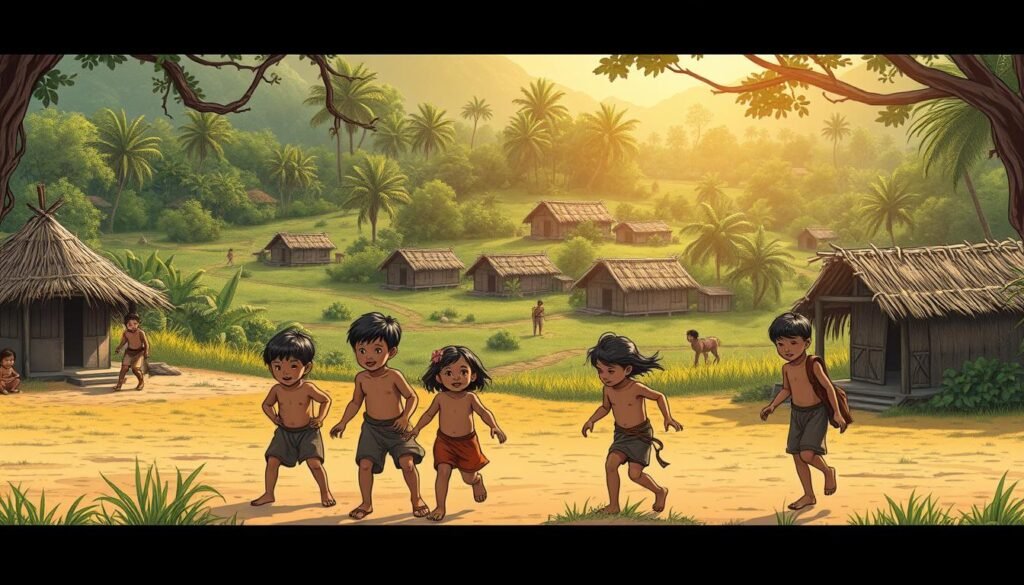
Cultural Views on Youth and Innocence
Early Filipinos believed that the young were not just innocent but also capable of contributing to the community. This perspective shaped how they were raised and integrated into daily life. From infancy, they were taught skills essential for survival, such as farming and household tasks.
Over time, these views evolved, reflecting broader societal changes. The arrival of colonial influences brought new ideas about childhood, leading to a shift in cultural interpretations. This change marked a transition from communal upbringing to more structured educational systems.
Rituals and ceremonies played a significant role in marking the passage of time. For example, the pag-anito ceremonies celebrated milestones in a child’s life, symbolizing their growth and readiness for new responsibilities. These traditions underscored the cultural importance of youth and their evolving roles.
Comparative Cultural Insights
Comparing early Philippine views with modern perceptions reveals fascinating contrasts. Today, childhood is often seen as a time of learning and play, whereas in pre-colonial times, it was a period of active participation in communal life. This historical context highlights how societal values have shifted over time.
Here’s a table summarizing key differences:
| Aspect | Pre-Colonial Philippines | Modern Philippines |
|---|---|---|
| Role of Youth | Active contributors to family and community | Focus on education and personal development |
| Cultural Rituals | Ceremonies marking growth and responsibilities | Celebrations focused on milestones like birthdays |
| Perception of Innocence | Innocence tied to capability and readiness | Innocence associated with protection and care |
Understanding these historical perspectives offers valuable insights into the cultural evolution of childhood in the Philippines. It also highlights the enduring influence of early traditions on modern societal values.
Children’s Roles in Family and Community Dynamics
In pre-colonial Philippine society, every family member, regardless of age, had a role to play. The family unit was the cornerstone of community life, and each person contributed to its success. This collective effort ensured the survival and prosperity of the entire home and beyond.
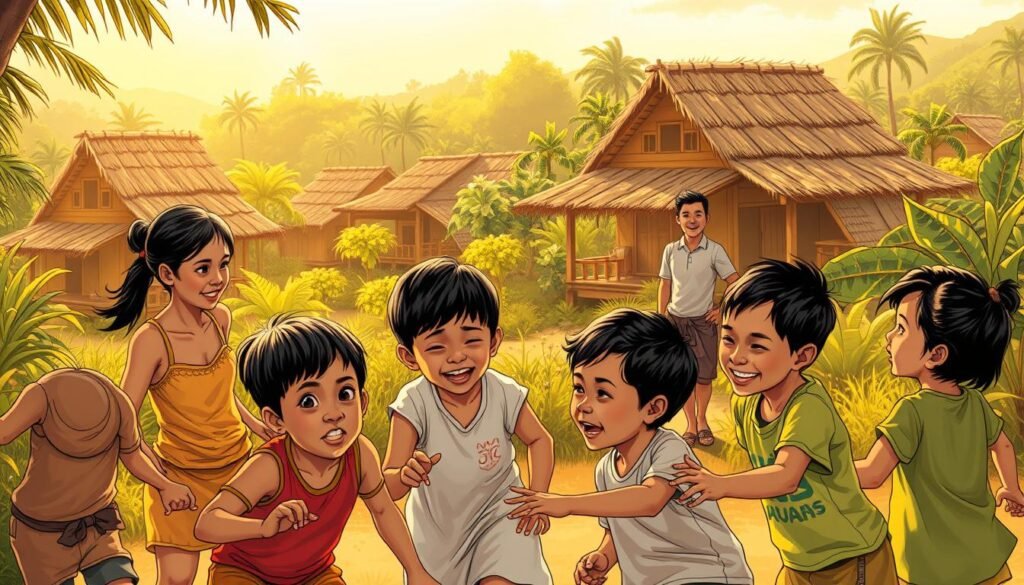
Family Structures and Kinship Ties
Kinship ties were the backbone of pre-colonial Philippine families. These bonds extended beyond immediate relatives, creating a network of support and cooperation. Every person, including the young, was integrated into daily work routines. This early involvement fostered a sense of responsibility and belonging.
Families were not just units of care but also centers of productivity. Tasks like farming, fishing, and crafting were shared among members. This division of labor ensured that everyone, including the youngest, played a part in sustaining the home and community.
Social Duties and Early Responsibilities
From an early age, young members were taught essential skills. These lessons were not just about survival but also about contributing to the community. Their roles included assisting in household chores, caring for siblings, and participating in communal activities.
This early training prepared them for adulthood while reinforcing the values of support and cooperation. The family unit functioned as a microcosm of society, where every person had a role to fulfill. This structure ensured that the community thrived through shared efforts.
Here are some key aspects of their roles:
- Active participation in family and community tasks.
- Early training in skills essential for survival.
- Integration into daily work routines.
- Strong emphasis on kinship and mutual support.
The Role of “Children” in Social and Ritual Traditions
In pre-colonial Philippines, young members of society were deeply woven into the fabric of cultural and spiritual traditions. Their participation in rituals and ceremonies was not just symbolic but also practical, reflecting their integral role in community life. These practices were essential for fostering a sense of belonging and continuity.
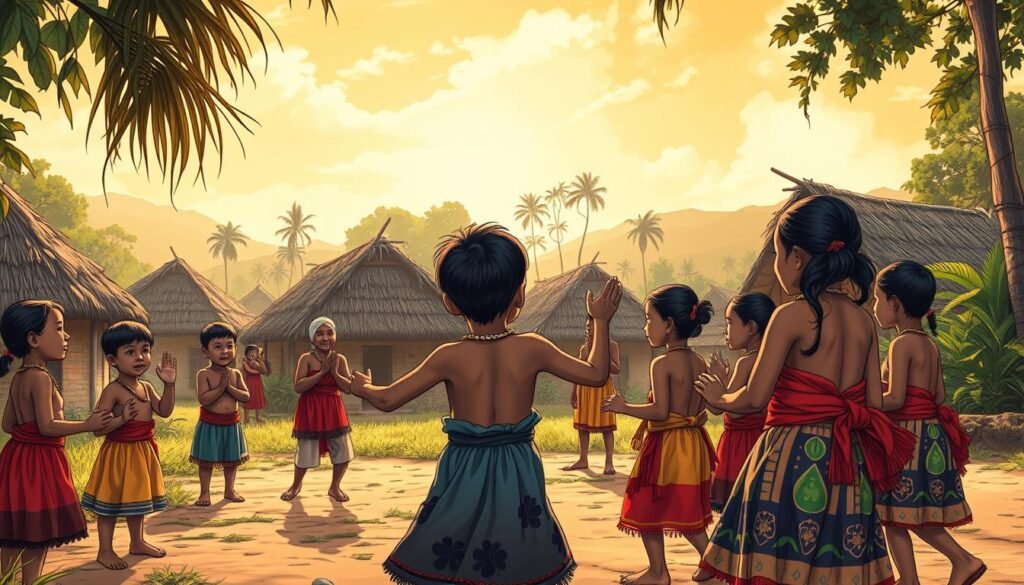
Ceremonial and Spiritual Contributions
Young individuals often played key roles in spiritual ceremonies, such as the pag-anito, which celebrated milestones and transitions. These rituals were not just about marking time but also about preparing them for future responsibilities. Their involvement in such events underscored their importance as resources for cultural renewal and preservation.
Modern discussions on policy often focus on protecting the young from violence and exploitation. In contrast, pre-colonial practices emphasized their active participation and value within the community. This historical perspective highlights the evolution of societal norms and the need for balanced approaches today.
Influence on Community Rituals
Community rituals in pre-colonial times were deeply collaborative. The young were often at the center of these events, symbolizing hope and continuity. Their roles ranged from assisting in preparations to actively leading certain ceremonies. This involvement reinforced their connection to the community and its values.
Today, efforts to prevent violence and ensure the well-being of the young are guided by comprehensive policy frameworks. While these measures are essential, they can also draw inspiration from historical practices that emphasized inclusion and respect for the young as vital resources.
Understanding these traditions offers valuable insights into the cultural evolution of societal roles. It also highlights the enduring importance of rituals in fostering community cohesion and identity.
Education and Informal Learning Among Pre-Colonial Youth
In pre-colonial Philippines, education was deeply rooted in community and practical life. Unlike modern systems, learning was informal, hands-on, and closely tied to daily responsibilities. This approach ensured that youth were well-prepared for their roles in society.
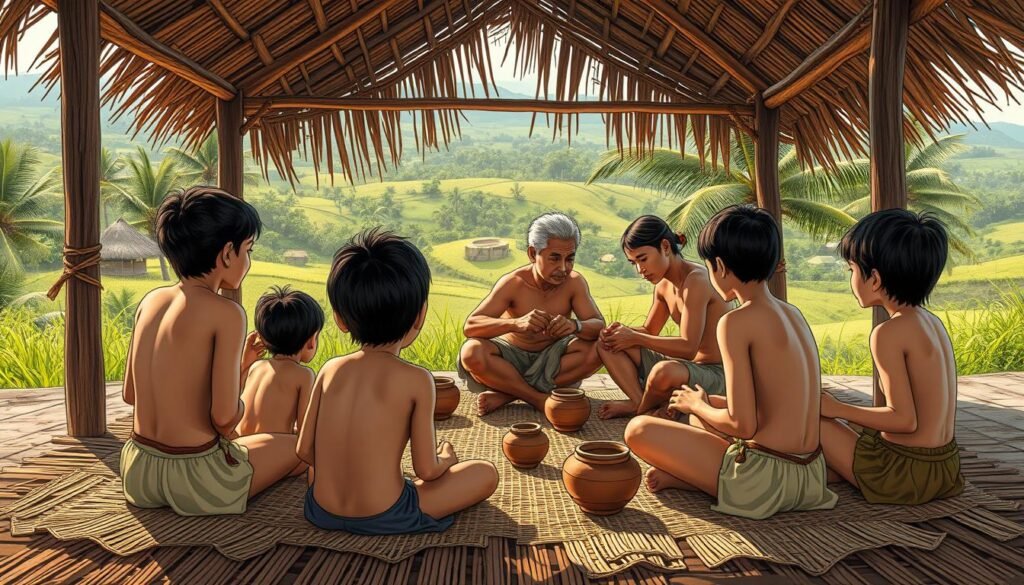
Traditional Methods of Skill Transmission
Mentorship played a central role in education. Elders and skilled community members passed down knowledge through observation and practice. This method emphasized experiential learning, where youth acquired skills like farming, fishing, and craftsmanship by doing.
Historical research highlights the effectiveness of these practices. For example, young individuals often learned by assisting in communal tasks, reinforcing their connection to the community. This approach not only taught practical skills but also instilled cultural values and a sense of responsibility.
Here are some key aspects of traditional education:
- Learning was integrated into daily life and communal activities.
- Mentors and elders were the primary teachers.
- Skills were passed down through hands-on experience.
- Cultural values were embedded in the learning process.
This informal system laid the foundation for future educational practices. It also highlights the importance of community in shaping the identity of youth. To explore more about ancient learning methods, check out this guide to the ancient Filipino script.
Modern research continues to uncover the richness of these traditions. These findings remind us of the enduring value of experiential learning and mentorship in education. This article provides a glimpse into how pre-colonial practices shaped the lives of young individuals and their communities.
Health, Nutrition, and Welfare in Early Childhood
Health and nutrition played a pivotal role in shaping the lives of the young in early Philippine society. Communities relied on indigenous knowledge to ensure their well-being, as there were no modern medical systems. Traditional practices were deeply rooted in the belief that a strong, healthy generation was essential for survival.
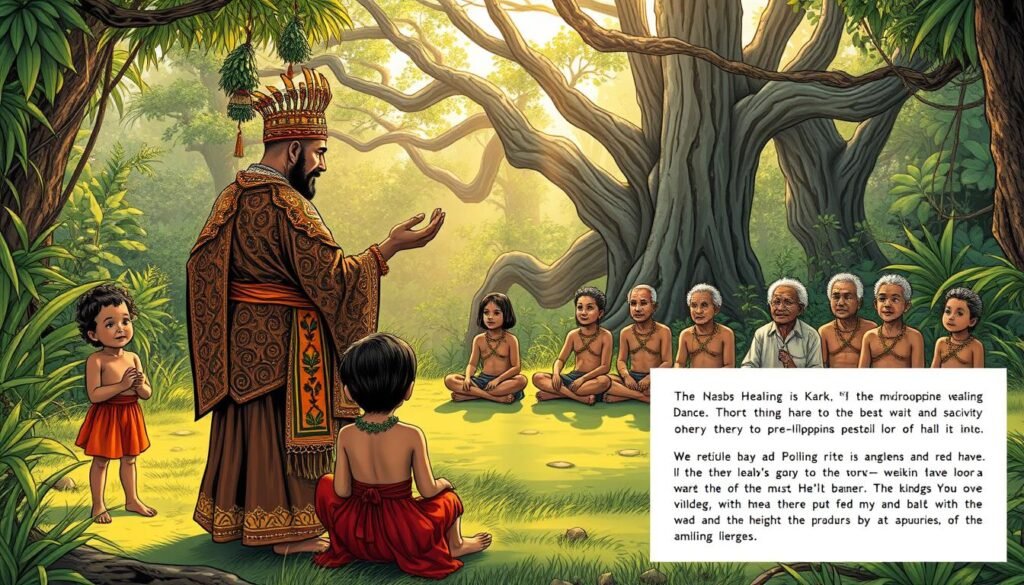
Traditional Health Practices and Nutrition
Pre-colonial Filipinos used herbal remedies and natural resources to treat illnesses. Plants like lagundi and sambong were common in addressing ailments. Nutrition was equally important, with diets rich in fish, rice, and vegetables. These practices were passed down through generations, ensuring continuity in care.
Despite these efforts, childhood death was a harsh reality. Limited resources and exposure to diseases posed significant risks. Communities developed rituals and preventive measures to protect their youngest members. For example, breastfeeding was encouraged to boost immunity, and communal support systems provided care for the sick.
Historical report data highlights the challenges faced. High infant mortality rates were common, but communities adapted by sharing knowledge and resources. This collective approach helped mitigate risks and fostered resilience.
Key aspects of traditional health and nutrition include:
- Use of herbal remedies for treatment and prevention.
- Balanced diets rich in local produce and seafood.
- Communal efforts to address health challenges.
- Rituals and practices to protect against diseases.
Understanding these practices offers valuable insights into the foundations of modern health systems. It also highlights the enduring importance of community in ensuring well-being. For more on how early care systems evolved, explore this resource on early childhood partnerships.
The Significance of Play and Cultural Expression
Play was more than just fun in pre-colonial Philippines; it was a vital part of cultural expression and learning. Through games, storytelling, and other activities, young individuals developed essential skills while connecting with their community. These practices were not only enjoyable but also deeply meaningful, shaping their understanding of the world around them.
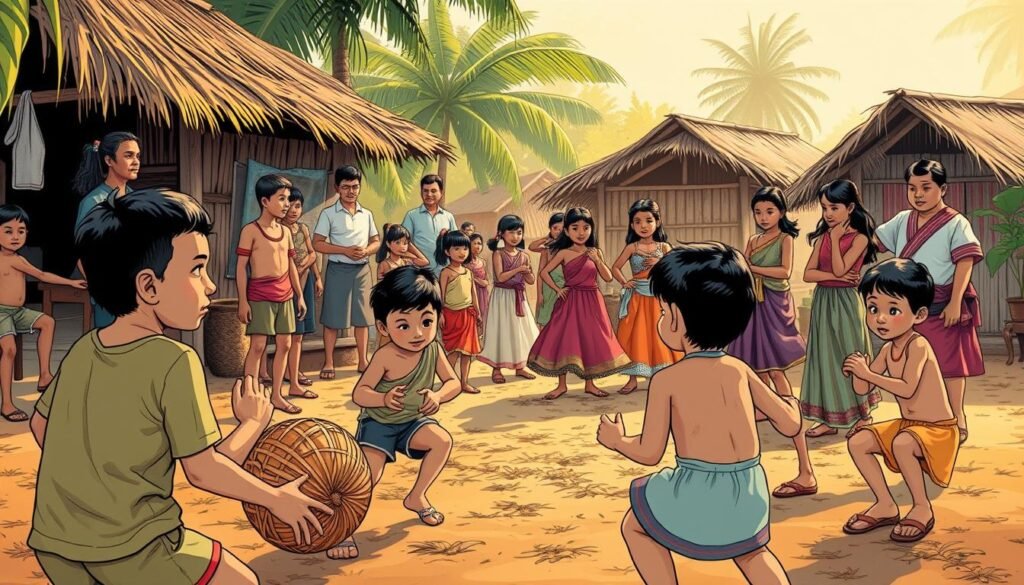
Traditional Games and Recreational Activities
Traditional games were a cornerstone of childhood in pre-colonial Philippines. Activities like sipa (kick game) and patintero (tag game) encouraged physical coordination and teamwork. These games were more than just pastimes; they were tools for teaching strategy, patience, and resilience.
Similar traditions can be found around world, from African drumming circles to Native American storytelling. These shared practices highlight the universal importance of play in fostering social and cognitive development. However, modern restrictions often pose a challenge to maintaining these traditions.
Storytelling and Oral Traditions
Storytelling was another key activity that enriched childhood experiences. Elders shared tales of heroes, myths, and moral lessons, passing down cultural values through generations. This oral tradition not only entertained but also educated, helping young individuals understand their place in the world.
Globally, storytelling has been a powerful tool for preserving history and teaching life lessons. From the epic poems of ancient Greece to the fables of India, these practices demonstrate the enduring value of oral traditions. Yet, balancing structured roles with creative expression remains a challenge in many societies today.
| Aspect | Pre-Colonial Philippines | Global Practices |
|---|---|---|
| Purpose of Play | Cultural expression and skill-building | Social and cognitive development |
| Common Activities | Traditional games, storytelling | Drumming, fables, team sports |
| Modern Challenges | Preserving traditions | Balancing structure and creativity |
Play continues to be a powerful tool for learning and growth. To explore more about its importance, check out this resource on the role of play in.
Gender Roles and Expectations in Early Philippine Society
Gender roles in early Philippine society were deeply rooted in cultural traditions and family expectations. These roles shaped the lives of young individuals, dictating their responsibilities and opportunities within the community. The child family dynamic played a crucial role in reinforcing these norms, ensuring that each member contributed to the household and society.
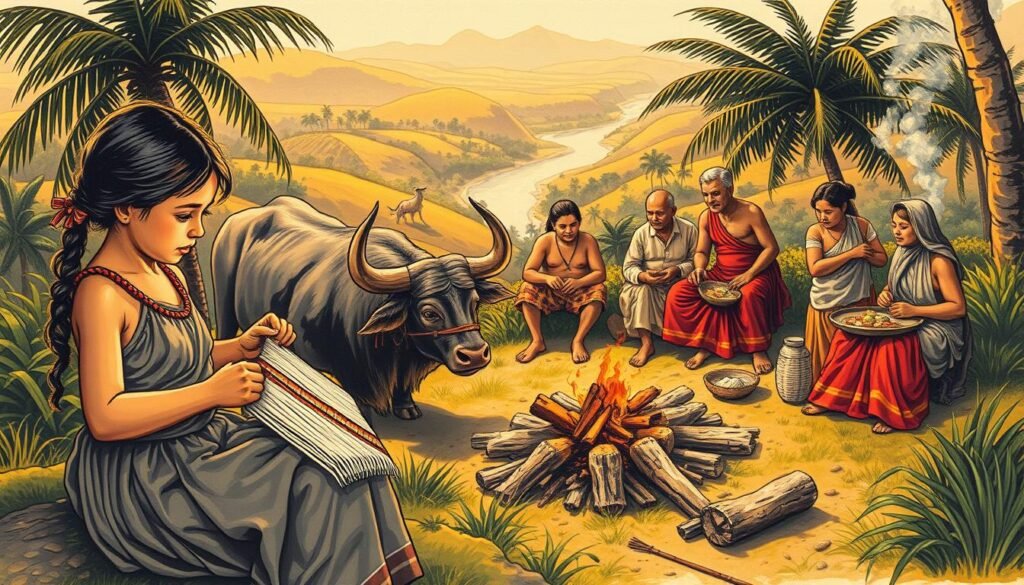
Different Paths for Boys and Girls
In pre-colonial Philippines, boys and girls followed distinct paths from an early age. Boys were often trained in skills like hunting, fishing, and farming, preparing them for roles as providers. Girls, on the other hand, were taught household tasks and caregiving, emphasizing their role in maintaining the child family unit.
Over the course of a year, these roles evolved with seasonal and social cycles. During planting seasons, boys assisted in the fields, while girls took on more responsibilities at home. This division of labor ensured that each gender had specific duties that contributed to the family’s survival and prosperity.
Access to certain roles was also influenced by gender. Boys had more opportunities to participate in communal activities and decision-making, while girls were often confined to domestic spaces. This disparity in access shaped their life trajectories, reinforcing traditional gender norms.
Cultural practices further reinforced these roles. Rituals and ceremonies often highlighted the distinct responsibilities of boys and girls, preparing them for adulthood. For example, boys might participate in initiation rites, while girls were celebrated for their skills in weaving or cooking.
Understanding these historical perspectives offers valuable insights into the evolution of gender roles in the Philippines. It also highlights the enduring influence of cultural traditions on modern societal expectations. For more on this topic, explore gender roles within the Philippines.
Economic Contributions and Early Work Practices
Economic stability in pre-colonial Philippines relied heavily on the collective efforts of all community members. Every individual, regardless of age, played a role in sustaining the country’s economy. This system ensured that even the youngest members contributed to the survival and prosperity of their families and communities.
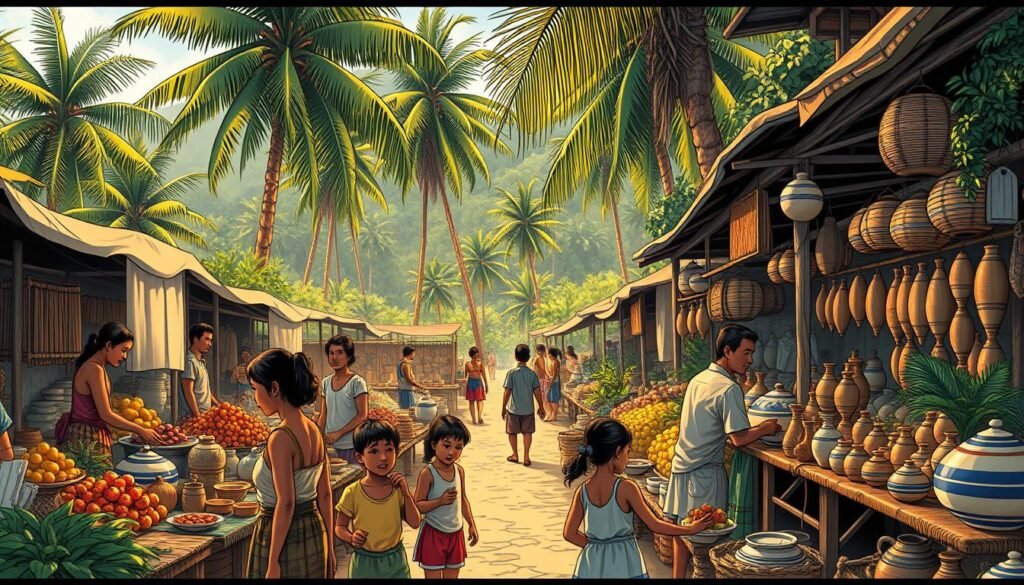
Child Involvement in Labor and Community Support
Young members of society were actively involved in daily tasks that supported their households and the broader community. From farming to fishing, their contributions were essential for the service of their families. These roles were not just chores but vital responsibilities that ensured the community’s survival.
In pre-colonial times, work was integrated into daily life. Tasks were divided based on age and ability, ensuring that everyone contributed. For example, young individuals often assisted in planting and harvesting crops, a critical activity for the country’s agricultural economy. This early involvement taught them valuable skills and instilled a sense of responsibility.
Communal activities also relied on the participation of young members. Whether it was preparing for festivals or helping with trade, their efforts were part of a larger system of service. This collective approach ensured that no task was too small or insignificant.
Here are some key aspects of their economic roles:
- Active participation in farming, fishing, and household tasks.
- Integration into daily day-to-day activities that supported the community.
- Learning practical skills through hands-on experience.
- Contributing to communal events and trade activities.
Understanding these historical practices offers valuable insights into the economic foundations of pre-colonial society. It also highlights the enduring importance of collective effort in shaping a country’s prosperity. For more on how early contributions influenced modern economic systems, explore this resource on economic development.
Conclusion
In pre-colonial Philippine society, every part of the community played a vital role in shaping the lives of its youngest members. From family to broader societal structures, the number and quality of contributions made by the young were essential for survival and growth. Their involvement in daily tasks, rituals, and communal activities highlights their importance in maintaining the balance of early society.
These historical roles have left a lasting impact on modern Filipino culture. The values of responsibility, community, and shared effort continue to influence how society views the younger generation. Understanding these traditions offers valuable insights into the evolution of societal norms and the enduring importance of family and community.
For more on how early practices shaped modern perspectives, explore this resource on developmental influences. Reflecting on these historical roles reminds us of the timeless significance of every part of society in fostering growth and resilience.
FAQ
What were the social structures like in pre-colonial Philippine society?
Pre-colonial Philippine society was organized into barangays, small communities led by a chieftain called a datu. These communities were built on kinship ties and shared responsibilities.
How were community roles defined in early Philippine culture?
Roles were based on age, gender, and skills. Everyone, including the young, had specific duties that contributed to the family and community’s well-being.
How did early Philippine culture view childhood and innocence?
Childhood was seen as a time of learning and preparation for adulthood. Youth were valued for their potential and taught to contribute to their families and communities.
What were the family structures like in pre-colonial Philippines?
Families were extended, with strong kinship ties. Relatives often lived together or nearby, fostering a sense of unity and shared responsibility.
What were the social duties of children in pre-colonial society?
They helped with household chores, assisted in farming, and participated in community activities. These tasks prepared them for adult roles.
How did children contribute to rituals and ceremonies?
They played roles in spiritual and cultural events, such as dances, chants, and offerings, symbolizing purity and continuity in traditions.
How were skills and knowledge passed down to the youth?
Skills were taught informally through observation, practice, and storytelling. Elders and family members were the primary teachers.
What were traditional health practices for children in early Philippine society?
Herbal remedies, massages, and rituals were used to ensure well-being. Nutrition relied on locally available foods like rice, fish, and vegetables.
What role did play and storytelling have in pre-colonial culture?
Traditional games and oral storytelling were essential for teaching values, history, and cultural identity while fostering creativity and social bonds.
How did gender roles differ for boys and girls in early Philippine society?
Boys were often trained in hunting or fishing, while girls learned weaving and household management. Both were prepared for their future roles in the community.
How did children contribute economically in pre-colonial times?
They assisted in farming, fishing, and crafting, supporting their families and communities while learning essential skills for adulthood.
Source Links
- Clues from Early Spanish Chronicles: Reconstructing Marriage and Family in the Pre-Hispanic Philippines
- The Philippines at the Turn of the Sixteenth Century. Childhood
- Precolonial barangay
- No title found
- Cultural achievements of pre-colonial Philippines
- Child Development | Child Rights: History, Facts & How To Protect Them
- An Inheritance that Cannot Be Stolen: Schooling, Kinship, and Personhood in Post-1945 Central Philippines | Comparative Studies in Society and History | Cambridge Core
- Roles Within the Family
- Family Dynamics and Child Outcomes: An Overview of Research and Open Questions
- The Importance of Rituals and Traditions in Early Learning: Now More Than Ever!
- Family rituals: what are they?
- A brief history of informal education – infed.org
- Education | Definition, Development, History, Types, & Facts | Britannica
- History | Department of Education
- Early Childhood Development and Education – Healthy People 2030
- Early Childhood Education | Health Impact in 5 Years | OPPE
- Children’s Well-Being
- Learning Through Play | Encyclopedia on Early Childhood Development
- Frontiers | Learning Through Play at School – A Framework for Policy and Practice
- The Impact of Dramatic Play in Early Childhood Education
- Women’s work? Challenging gender roles in the Philippines – Views & Voices
- Frontiers | Evolved but Not Fixed: A Life History Account of Gender Roles and Gender Inequality
- http://www.fes.org.ph/papers_gendersit.htm
- Child Labor: Laws & Definition | HISTORY
- Child Labor and Children’s Economic Contributions
- Child labor: Facts, FAQs, and how to help
- Conclusions and Recommendations – From Neurons to Neighborhoods
- Conclusion on Children at Risk | UNHCR

